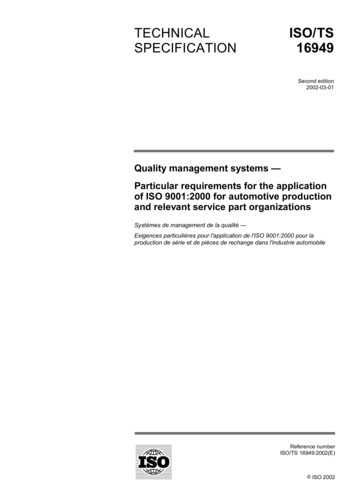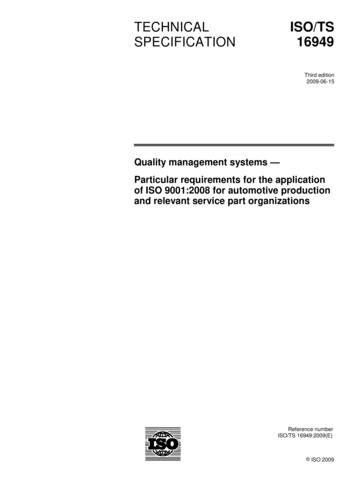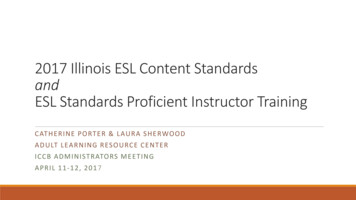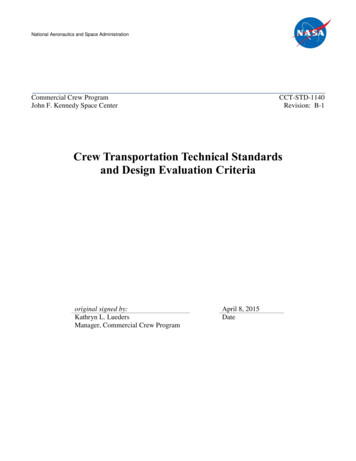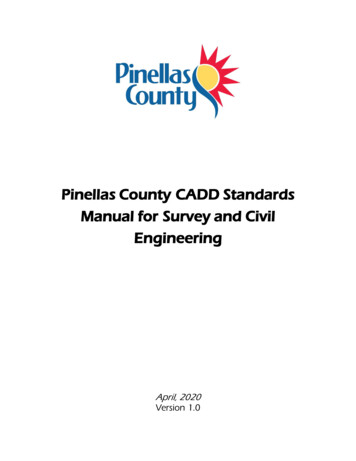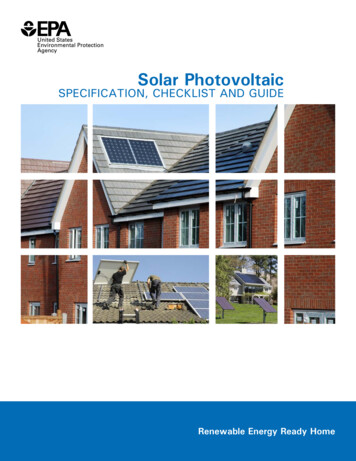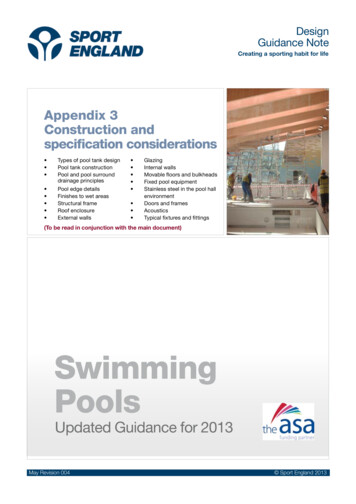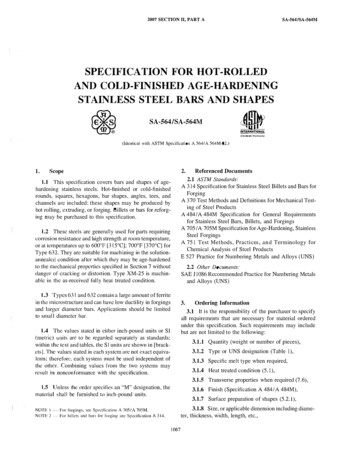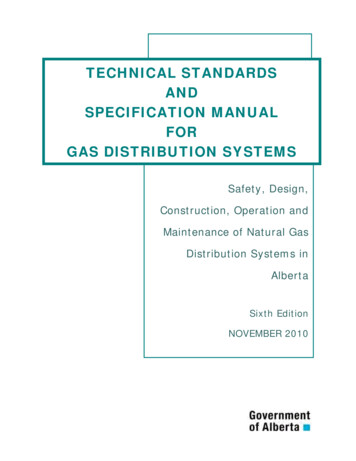
Transcription
TECHNICAL STANDARDSANDSPECIFICATION MANUALFORGAS DISTRIBUTION SYSTEMSSafety, Design,Construction, Operation andMaintenance of Natural GasDistribution Systems inAlbertaSixth EditionNOVEMBER 2010
ForewordThis Sixth Edition of the Technical Standards and Specifications Manual has beenupdated to reflect changes to technical standards which have occurred since 2005.This manual is issued in accordance with provisions of Section 2(1) of theGas Distribution Act and should therefore be considered as having the sameauthority as the Act.Any inquiries concerning this manual should be referred to:Bruce PartingtonSenior Safety Technical AdvisorRural Utilities DivisionAlberta Agriculture and Rural DevelopmentEdmonton, ABPhone: 780-427-0125Fax: 780-422-1613Email: bruce.partington@gov.ab.ca
Table of ContentsPAGE1.Scope and Application . 12.Reference Legislation, Regulations and Standards . 33.Definitions. 44.Design . 54.1General. 54.2Establishing Peak Hour Design Loads . 54.2.1.Maximum Connected Load . 54.2.2Peak Design Loads.64.2.3Establishing Coincidence Factors . 64.2.4Consumer Load Surveys . 64.2.5Degree Day Method. 84.3Sizing of Distribution Systems . 84.4.General Design of Distribution Systems . 84.5Routing of Distribution Systems. 94.6Depth of Cover and Clearance . 104.7Crossings of Other Facilities. 104.8Pipelines Parallel to Roads Administered by Counties and MunicipalDistrict . 174.95.Use of Road Rights-of-way as Pipeline Rights-of-way . 19Construction .215.1General. 215.2Material Specifications. 215.3Materials Handling. 225.4Project Management . 225.5Right-of-Entry and Crossing . 235.6Pipeline Jointing . 235.75.6.1Welding of Steel or Aluminum Pipe . 235.6.2Joining of Reinforced Thermoplastic Pipe. 245.6.3Fusion of Polyethylene Pipe . 24Pipeline Installations. 25
6.7.5.8Surface Installations . 255.9Warning Signs .275.10Domestic Meter Installations . 275.11Cathodic Protection . 31Regulator Stations and Isolation Valve Assemblies. 336.1General. 336.2Regulator Stations . 336.3Isolation Valve Assemblies . 38Testing and Qualifying of Pipelines.437.1General. 437.2Maximum Operating Pressures . 437.3Pressure Testing . 437.4Design Qualification of Low Pressure Pipelines . 467.5Increasing the Maximum Operating Pressure . 487.6Interconnecting Low Pressure Pipelines With Different MaximumOperating Pressures. 488.Pipeline Surveys and Plan Location Records . 498.1General. 498.2Pre-Construction Surveys. 498.3As-Built Surveys . 508.3.1High Pressure Pipelines. 508.3.2.Low Pressure Pipelines . 508.49.Plant Location Records . 518.4.1.Digital Mapping Files. 518.4.2.Relevant Documents. 52Operations and Maintenance. 559.1.General. 559.2Operations and Maintenance Manuals . 559.3Training . 569.4Pipeline Location for Third Parties. 56
List of FiguresPAGE1.1Scope of Manual. 24.1Load Survey Form . 74.2Standard Dimensional Information for Highway or Road Crossings . 114.3Typical Highway or Road Crossings. 124.4Typical railway Crossing . 134.5Typical Water/Canal Crossing . 144.6Typical Pipeline Crossing . 154.7Typical cable Crossing . 164.8Control Areas for pipelines Parallel to Roads . 184.9Pipeline Installations in Rural Road/Highway Rights-of-way. 205.1typical Cross section of Sand-padded Rock Ditch . 265.2Location of Regulator Vent Relative to Building Openings . 285.3Typical Domestic Meter Set. 295.4Typical Riser Assembly . 305.5Typical Test Station c/w Anode Installation . 326.1Typical Single Run, Single Cut Reg. Station. 346.2Typical Single Cut, Double Run Reg. Station . 356.3Typical Double Run, Single Cut Reg. Station . 366.4Typical Double Run, Double Cut Reg. Station. 376.5Typical Underground Polyethylene Isolation Valve Assembly . 396.6Typical Underground Steel Isolation Valve Assembly . 406.7Typical Above Ground H.P. Steel Isolation Valve Assembly . 416.8Typical Above Ground Polyethylene Isolation Valve Assembly . 427.1Pipeline Test Confirmation . 457.2Pipeline Information Data Form . 478.1Sample of Township As-Built Plan. 538.2Sample of Subdivision As-Built Plan. 54
AppendicesADegree Day Methods for Establishing Peak Hour Design Loads. 57BControl Areas for Low Pressure Pipelines Paralleling Municipal Roads . 60CLeak / Damage Report Form . 62
-1-1. Scope and ApplicationThe scope of this manual is illustrated with Figure 1.1 and includes:(a)Any part of a gas distribution system within a franchise area that has beenapproved and issued under the authority of the Gas Distribution Act.(b)Any gas distribution pipeline operating at 700 kPa or less which is located withinAlbertaThis manual covers the key aspects of safety, design, construction and operation, whichthe Chief Officer (as defined in the Gas Distribution Act) (the Division) considers necessaryfor the orderly and effective development of gas distribution systems.
-2-LegendMsMsHigh PressureMeter StationRsPressureRegulatingStationcmCustomer sEnergyResourcesConservationBoardRsUrban AreacmcmcmcmRural UtilitiesDivisionJoint Board &DivisioncmcmAlberta MunicipalAffairsFIGURE 1.1 SCOPE OF MANUALNOTES:1. High pressure pipelines that are downstream of transmissionpipelines have a joint Board/Division responsibility as per the GasDistribution Act.2. Secondary gas line downstream of the service regulator(Customer meters) are the under the regulatory authority ofMunicipal Affairs.November 2010
-3-2. Reference Legislation, Regulations and StandardsThe design, construction and operation of gas distribution systems are subject to statutesand regulations issued by the Government of Alberta and the Government of Canada. Inaddition, applicable publications of the Alberta Occupational Health and Safety Code, theCanadian Standards Association (CSA) and other organizations should be consulted.The latest edition of the CSA standard published as CAN/CSA Z662 “Oil & Gas PipelineSystems” should be considered as the principal guideline for the design, construction andoperation of distribution systems. Regulations covering gas pipeline systems in Albertarequire compliance with the CAN/CSA Z662 standard, although these regulations includesome variations to provisions in the standard.Since the scope of this manual covers some distribution pipelines, which fall within thejurisdictions of the Rural Utilities Division (the Division), the Energy ResourcesConservation Board (the Board) and the Safety Services Branch of the Public SafetyDivision of Alberta Municipal Affairs (Municipal Affairs), the following principles shouldapply where dual jurisdiction exists:(a)Where a minimum specification issued by the Board exceeds a specificationcontained in this manual, the Board’s specification shall prevail.(b)Where a minimum specification contained in this manual exceeds a specificationissued by the Board, the specification in this manual shall prevail.(c)Where a minimum specification issued by Municipal Affairs exceeds a similarspecification contained in this manual, the Municipal Affair’s specification shall prevail.(d)Similarly, where a minimum specification issued by any other Provincial or NationalAct /Regulation exceeds a similar specification contained in this manual, that Act orRegulation’s specification shall prevail.
-4-3. Definitions“The Division” means the Rural Utilities Division of the Department of Agriculture andRural Development.“Distribution System” means an integrated network of distribution pipelines andassociated appurtenances.“Distribution Pipeline” means a pipeline used to transport and deliver gas to consumers.“Distributor” means the person or corporation that owns a distribution pipeline ordistribution system.“Ground disturbance” means any work, operation or activity that results in a disturbanceof the earth including, without limitation, excavating, digging, trenching, plowing, drilling,tunneling, auguring, backfilling, blasting, topsoil stripping, land leveling, peak removing,quarrying, clearing and grading, but does not include:(i) Except as otherwise provided in sub-clause (ii) below, a disturbance of the earth toa depth of less than 300 mm that does not reduce the earth cover over the pipelineto less than the depth of cover provided when the pipeline was installed.(ii) Cultivation to a depth of less than 450 mm below the surface of the ground.“High pressure pipeline” means a distribution pipeline, which is designed to be licensedand/or to be operated at a pressure in excess of 700 kPa.“Low pressure pipeline” means a distribution pipeline which is designe
be using the dry gas distribution Design Coefficient (C a) 1.6 in the MRS design formulas to ensure a 50-100 year life of the gas distribution system. 4.2 Establishing Peak Hour Design Loads In the design of a distribution system, pipe sizing is influenced primarily by the maximum hourly volume of gas, which the system is required to .
![[MS-ADTS-Diff]: Active Directory Technical Specification](/img/1/ms-adts-170316-diff.jpg)
